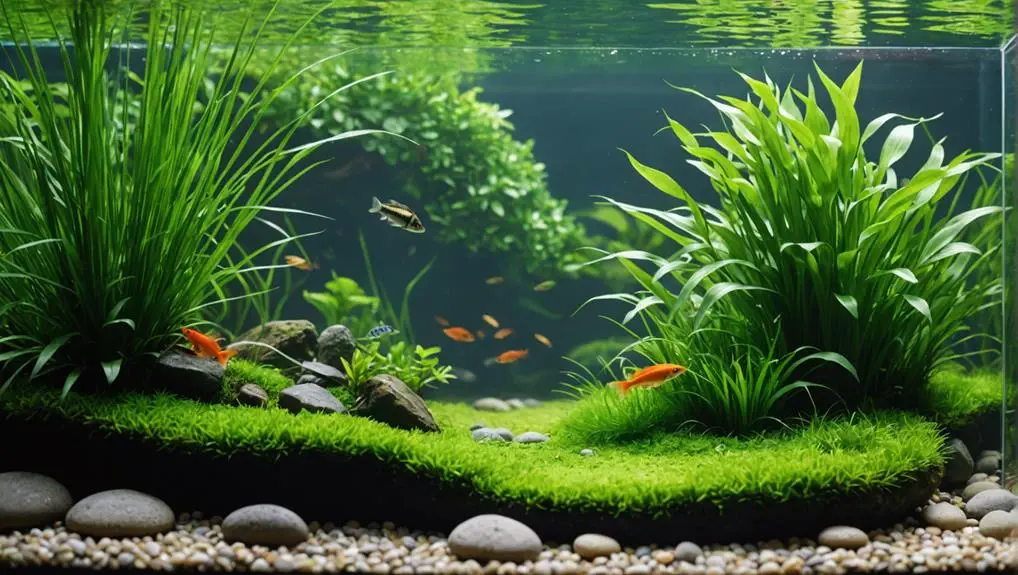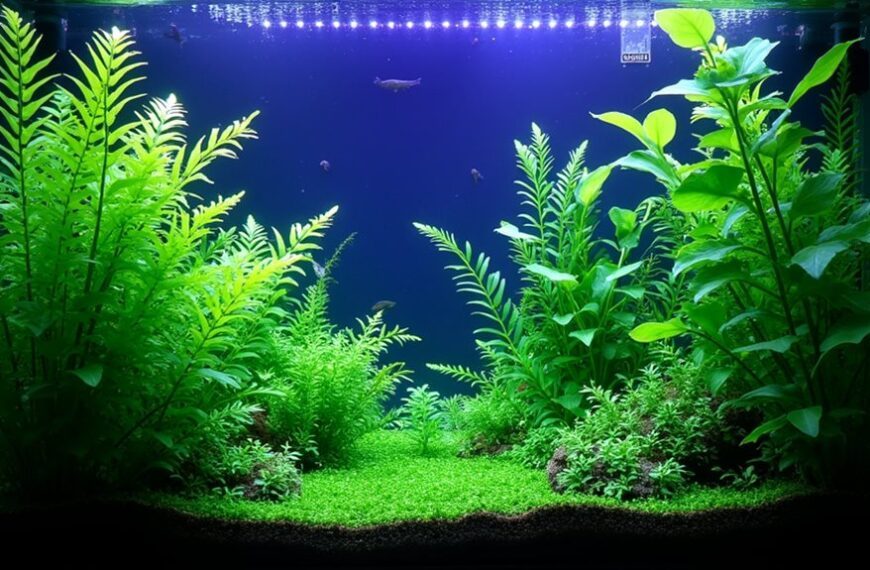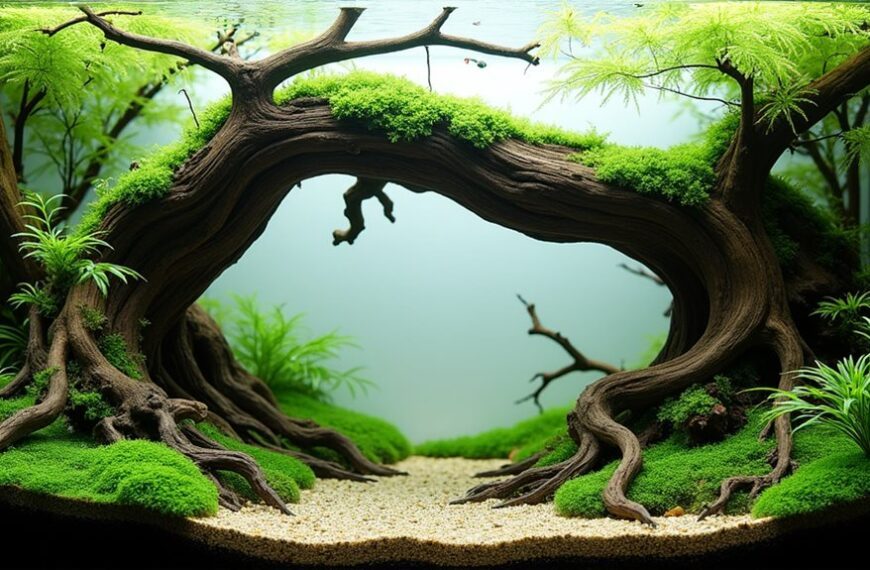Aquascaping your new fish tank is like creating an underwater magic show, and it doesn't have to be tricky! Start by choosing the right substrate; gravel's great for beginners, while plant substrates boost plant growth. Next, mix in some rocks and driftwood for hiding spots and visual flair. When selecting plants, think about placing taller ones in the back for a neat look. Don't forget to keep things clean and test your water quality regularly. Finally, add fish gradually to keep things balanced. Keep going, and you'll uncover even more tips to make your tank shine!
Contents
Choosing the Right Substrate
Choosing the right substrate is crucial for your aquarium's health and aesthetics. It's like picking the perfect outfit for a special occasion!
For beginners, gravel often shines as a top choice. It's cost-effective, easy to clean, and supports beneficial bacteria, which are the good guys in your tank. Additionally, the substrate you choose can influence water chemistry, impacting the overall well-being of your fish and plants its impact on water chemistry.
However, if you're dreaming of a lush, planted paradise, you might want to consider plant substrates. These nutrient-rich options help plants root deeply and thrive, making your underwater world vibrant.
On the flip side, sand offers a softer texture that some fish love. Just keep an eye on it; if you're not careful, it can create those pesky anaerobic pockets that can harm your aquatic friends.
Aim for a substrate depth of about 2-3 inches to ensure proper aeration and support for plant roots. And don't forget to rinse your substrate thoroughly before adding it to the tank—nobody wants cloudy water or unhappy fish!
Essential Hardscape Materials
When creating your aquarium's landscape, incorporating essential hardscape materials can significantly enhance its beauty and functionality.
Think of hardscape as the bones of your underwater world, providing structure and a natural vibe. Start with rocks like slate, granite, or lava rock, which help maintain stable water temperatures and quality, ensuring a healthy environment for your fish. They not only look great but also mimic the underwater environments your fish thrive in.
Plus, different colors and textures can add depth and visual interest to your setup. For more insights on selecting appropriate fish species for your tank, check out nano species for small tanks.
Driftwood is another must-have. It offers cozy hiding spots for your fish and can even boost water chemistry by leaching beneficial tannins. Your fish will appreciate it, and you'll enjoy watching them explore their new terrain.
Don't forget about your substrate! Using gravel or sand as a foundational layer supports your aquarium plants while helping to balance the ecosystem.
Just make sure all your materials are safe for aquatic life, free from harmful coatings or chemicals that could leach into the water.
With the right combination of rocks, driftwood, and substrates, you're on your way to creating a stunning aquascape that not only looks good but also serves your fish well.
Happy aquascaping!
Plant Selection and Arrangement
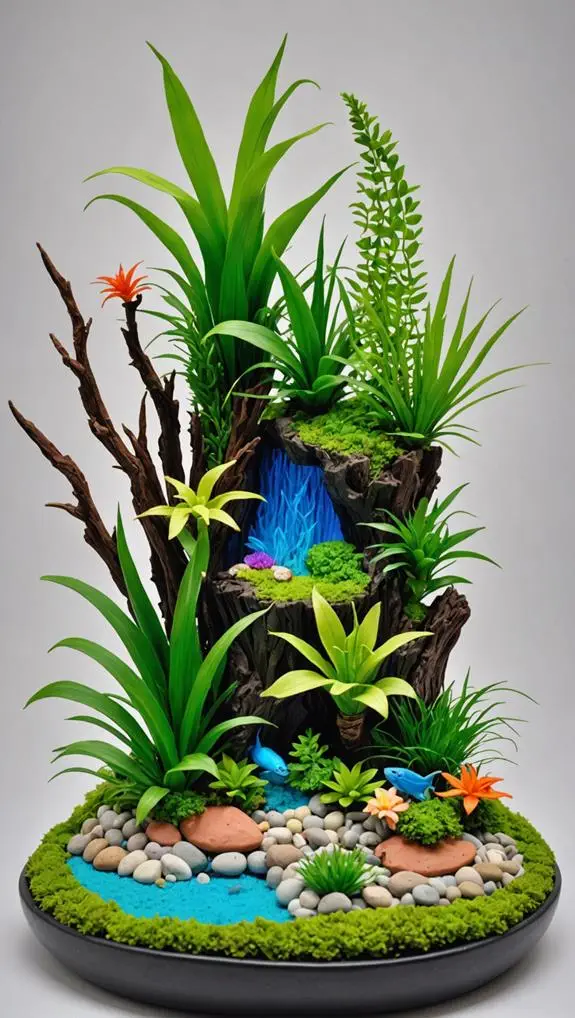
How can you create a vibrant and balanced aquascape? Start with thoughtful plant selection. Choose a mix of aquatic plants with varying heights: foreground plants like Monte Carlo for that lush carpet, midground favorites like Anubias, and tall background plants such as Cryptocoryne.
This layering adds depth and makes your tank visually appealing. Additionally, maintaining optimal water quality is crucial for plant health and fish well-being; regular testing of parameters like pH and nitrates can greatly enhance your aquascaping success essential test parameters.
When you plant, skip the tying! Just place the plants naturally in the substrate, making sure their roots are buried for healthy growth. If you want a thriving carpet, try the Lazy Dry-Start Method B. Sprinkle Monte Carlo on your soil before adding water to kickstart its growth.
Remember to consider light requirements. Put high-light plants near the light source and shade-loving plants in dimmer spots. This way, your fish and plants will both thrive.
And don't forget: regular pruning and trimming encourage bushier growth, especially with stem plants like Ludwigia. Plus, keeping an eye on dead leaves helps maintain water quality.
With a bit of care and creativity, your tank won't only look great but also serve as a healthy home for your fish. Happy planting!
Maintenance Tips for Aquascaping
Creating a vibrant aquascape requires ongoing maintenance to keep your underwater landscape thriving.
Start by cleaning your CO2 diffusers with a bleach solution. This ensures efficient CO2 flow and prevents any unwanted contamination in your planted tank.
Don't forget those hard-to-reach corners! A 45-degree angle scraper or a toothbrush works wonders for maintaining a clean and visually appealing aquarium.
To improve water quality, prime your filters properly. Fill them with water before installation, either by using a primer button or just a little suction on the hose. It really boosts filter efficiency.
When it comes to glass, be gentle—clean it with a plastic card instead of abrasive materials that might scratch the surface.
Lastly, regularly assess the positioning of your plants and decorations. Adjusting them not only encourages optimal growth but also promotes natural behavior in your fish.
It enhances the overall aesthetic of your aquascape. Remember, a beautiful aquarium is a labor of love, and your efforts will pay off as you watch your underwater paradise flourish!
Enjoy the journey of maintaining your aquatic masterpiece!
Creating a Balanced Ecosystem
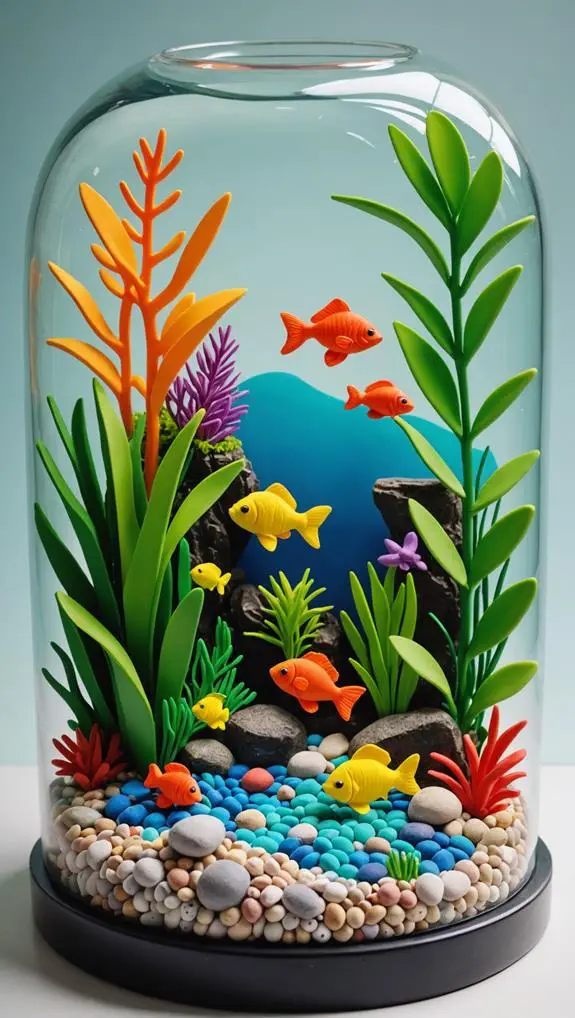
A thriving aquarium hinges on establishing a balanced ecosystem that supports both your plants and fish. To get this right, you need to take a few essential steps.
First, cycle your tank with beneficial bacteria for 1-2 weeks. This helps create stable water parameters before you add any aquarium fish. It's also crucial to regularly test water quality. Make sure to monitor ammonia, nitrite, and nitrate levels to keep everything safe for your fish.
Here are three key points to keep in mind:
- Incorporate a variety of live plants; they provide oxygen and control algae growth.
- Choose a filter that suits your tank size to maintain clean water.
- Gradually introduce fish, adding only a few at a time to help your ecosystem adjust.
Frequently Asked Questions
How to Set up a New Aquarium for Beginners?
To set up your new aquarium, choose suitable equipment, select the right substrate, and ensure fish compatibility. Monitor water parameters closely to create a thriving environment that serves both your aquatic life and your passion.
What Are Common Mistakes in a New Aquarium Set Up?
When setting up your aquarium, don't rush fish tank cycling while neglecting substrate selection and filter placement. Remember, balanced lighting options can enhance growth, but hasty decisions can lead to stress and illness for your future fish.
How to Take Care of a Fish Tank for Beginners?
To care for your fish tank, monitor water parameters regularly, ensure proper tank cycling, choose compatible fish, and manage algae effectively. These steps create a thriving environment, benefiting both your fish and your enjoyment.
What Should I Put in My Aquarium First?
So, you think tossing fish in first is a genius plan? Start with aquarium substrate options, then choose decorative elements wisely. Add aquatic plants next, following fish compatibility guidelines, ensuring your aquatic pals thrive together harmoniously!
Final Thoughts
So, there you have it! With the right substrate, some essential hardscape materials, and a splash of plants, you're on your way to creating a stunning underwater world. Remember, patience is key—just like waiting for that first batch of cookies to bake! Keep up with maintenance, and soon, you'll have a balanced ecosystem that's as vibrant as a coral reef. Dive in, have fun, and let your creativity flow in your new fish tank adventure!

